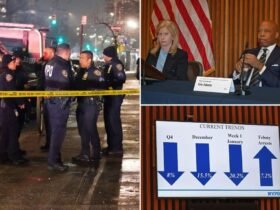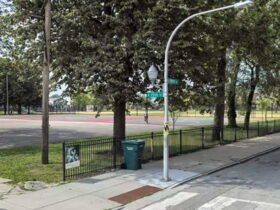Nearly 10% of New York City’s drugstores have closed this year — a dramatic drop after a decade of retreats that has left numbers down 40% as shoplifting remains rampant, an explosive study shows.
The number of Walgreens, Duane Reade, CVS and Rite Aid stores in the city will shrink to 395 locations by 2024. That’s up from 435 last year, and down sharply from a peak of 656 in 2014, according to The Center for an Urban Future’s annual report. titled “State of the chains.”
The hardest hit pharmacy chain was the largest in the city – Walgreens Boots Alliance – which owns Duane Reade. It closed 22 stores in the Big Apple, leaving just 189 locations, according to the report.
CVS, meanwhile, closed 10 stores, leaving behind 160 locations. Rite Aid, which filed for bankruptcy protection last year, closed eight stores this year and now operates just 46 in the city.
The victims this spring included two massive Duane Reade locations — one at 4 Times Square and the other at the corner of Broadway and West 50th Street. That’s after the 16,000-square-foot Walgreens flagship store at One Times Square closed its doors in 2022 after weathering the depths of the pandemic.
Also in 2022, a Rite Aid at Eighth Avenue and West 50th Street closed. It is now being redeveloped into a smaller-format Whole Foods store.
Experts blame not only the crime but also drugstores’ heightened security measures — most notably locking merchandise behind plexiglass, forcing customers to call and wait for store clerks for everything from shampoo to painkillers.
To avoid hassles, shoppers are skipping the drugstore altogether and buying more essentials online.
“There is no doubt that the lockdown, the move to automated checkout and fewer people working in these stores have contributed to fewer people going to their stores,” said Jonathan Bowles, executive director of The Center for an Urban Future, to The Post. .
“More New Yorkers can buy this merchandise online, but when they go to these stores, there are fewer people working and the items are locked up.”
There are likely more closures. CVS, which has 9,000 stores nationwide, announced in 2021 that it would close 900 stores over several years.
“Decisions are NOT based solely on shoplifting or crime,” a CVS spokeswoman told The Post when asked about the recent shutterings.
“Many factors are taken into account when closing a store, including population shifts, consumer purchasing patterns, store and pharmacy density, access to pharmacy care and community health care needs,” the spokeswoman added.
A spokesperson for Rite Aid said: “Like many in the industry, we are seeing increased levels of blatant shoplifting and organized retail crime. We take an active role in assisting law enforcement in their pursuit of shoplifters, and continue our efforts to educate community leaders about the impact of shoplifting and advocate for solutions.”
According to Bowles, the drugstore exodus is indeed wreaking havoc on the streets of the Big Apple.
“There is graffiti on vacant storefronts or on homeless people who have decided to go to sleep [by the entrance] because there’s no active store there, so it’s not healthy for our retail landscape,” Bowles said.
Walgreens Boots Alliance said in October that it plans to close 500 stores by 2025 and a total of 1,200 over the next three years.
The Chicago-based pharmacy chain, which has about 8,700 locations nationwide, said one in four stores is unprofitable and that they want to “improve our customers’ shopping experience.”
A Walgreens representative told The Post that the closures are caused by increased “regulatory and reimbursement pressures” that are “weighing on our ability to cover costs associated with rent, staffing and supply needs.”
The company has not directly linked its store closings to crime, but executives have said during earnings calls that “shrinking” — which in corporate parlance means theft — “represents a serious systemic problem in retail.”
The Big Apple’s drugstores have been particularly hard hit by a crime wave that accelerated with the onset of the pandemic in 2020.
Closed-door drugstores are responsible for “an disproportionate share of New York City’s vacancy” because demand is low for the larger spaces they typically occupy, Bowles added. By one measure, the empty drugstore space totals one million square feet, according to a New York Times report report in August.
“A few years ago I thought we had too many drugstores on almost every block,” said Tom Harris, president of the Times Square Alliance, a nonprofit that promotes development in the district. “But whenever a pendulum swings too far in one direction, it goes back.”













Leave a Reply